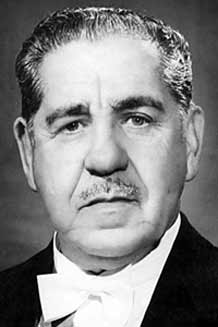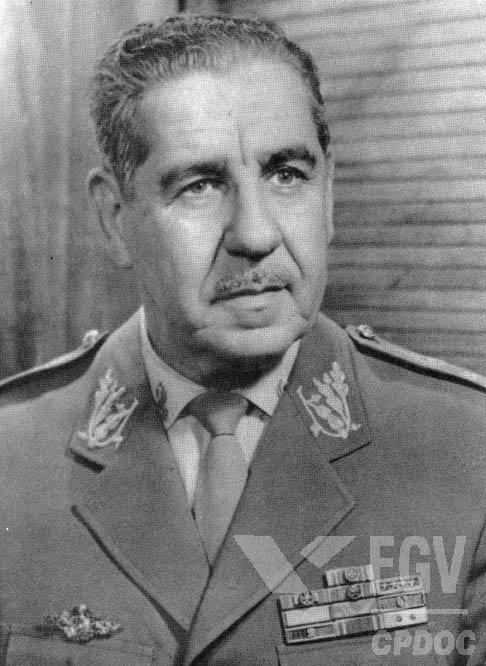<Back to Index>
- Chemist Charles John Pedersen, 1904
- Painter Alexander Young Jackson, 1882
- President of Brazil Artur da Costa e Silva, 1899
PAGE SPONSOR


Artur da Costa e Silva (October 3, 1899 – December 17, 1969) was a Brazilian Army General, the second President of Brazil during the military regime set up by the 1964 coup d'état. He was married to Iolanda Barbosa Costa e Silva, the daughter of a soldier. Born in the interior of Rio Grande do Sul, he reached the rank of Marshal of the Brazilian Army, and held the post of Minister of War in the government of the previous president, Marshal Castelo Branco.
His
government started the most oppressive stage of the military regime
against communists, which would be continued and expanded under his
successor, General Emílio Garrastazu Médici. It
was during Costa e Silva's term of government that the decree known as
the AI-5 (Institutional Act 5) was promulgated. This law gave the
president the power to dismiss the National Congress, strip politicians
of their offices of power, and institutionalize repressive methods of
rule against left wing parties and individuals. Several sources erroneously suggest that Costa e Silva's parents were Portuguese from Madeira. In fact, both his parents were Brazilians, although one of his great-grandparents was a Portuguese immigrant from Lisbon. Costa e Silva began his military career by entering the Military College of Porto Alegre, where he finished first of his class and commander of the cadet corps. He entered the Escola Militar de Realengo in Rio de Janeiro in 1918, where he finished third of his class. Made an aspirant on January 18, 1921, he was commissioned 2nd Lieutenant in 1922 and was stationed with the 1st Infantry Regiment in Vila Militar until July 5 of that year. Costa e Silva was promoted to general on August 2, 1952 and reached the final rank of Army General on November 25, 1961. He underwent training, as part of a joint program, in the United States of America from
January to June 1944, after having been an assistant instructor of
general tactics at the School for Command and the Army General-Staff.
He served as a military attaché in Argentina from 1950 to 1952, and was then appointed to the command of the 3rd Military Region (Rio Grande do Sul) from 1957 to 1959, and even later the command of the 4th Army (Pernambuco)
from August 1961 to September 1962. He was then appointed chief of the
General Personnel Department and then chief of the Department of
Production and Works. During the government of João Goulart,
Costa e Silva put down left wing student demonstrations that broke out
in the Northeast and was removed from the command of the 4th Army. At the
end of 1963, He actively participated in the plot that overthrew
Goulart's presidency (identified with Communism during the Cold War),
who the military accused of planning a coup d'état. Shortly thereafter Costa e Silva was appointed the Minister of War just after of victory of the 1964 Brazilian Revolution on April 1, 1964 and remained in that position after the start of the Castelo Branco government that was inaugurated several weeks later on April 15. As
Minister of War, Costa e Silva defended the interests of the so-called
hardliners during the Cold War, the ultraright faction of the Armed
Forces. As such he was considered an acceptable candidate to succeed
Castelo Branco as president. This also served well to isolate more
moderate soldiers - such as future president Ernesto Geisel and his future auxiliary Golbery do Couto e Silva - from posts of responsibility. While
Costa e Silva was campaigning for the Presidency of the Republic, he
barely escaped death during a left wing terrorist attack at Guararapes International Airport in Recife on
July 25, 1966. The attack happened while he was waiting alongside
around 300 other people at the airport. Several men were left dead or
injured in what became known as the Attack of the Guararapes. Since the
airplane that was supposed to take him had broken down earlier that day
in João Pessoa, Costa e Silva decided to leave Recife by automobile, thereby avoiding the assault. Costa
e Silva was elected president in an indirect election by the National
Congress on October 3, 1966 due the Revolution of 1964 and was sworn in
on March 15, 1967. The
new president suppressed the Broad Front (Frente Ampla), an opposition
movement that had brought together politicians from the pre-1964
period. He fought against inflation, revised government salaries and
enlarged exterior trade. He also began a reform of the administrative
organs, expanded the communication and transportation systems, but
failed to resolve the problems in the education system. His period was
used as a basis of the "Brazilian Miracle" - a growth rate ranging from
9-10% per year. In 1968, the death of college sophomore Edson Luís de Lima Souto in
a confrontation with a police officer provoked a massive protest (The
Hundred Thousand March) in Rio de Janeiro. The political situation
worsened in August, when deputy Márcio Moreira Alves recommended
in a speech that young women should refuse to dance with military
cadets in an act of protest against the military regime. The government
asked the National Congress to prosecute the deputy. Although Congress
was dominated by the pro-government ARENA,
the request was refused. Costa e Silva then called together the Council
of National Security and published a law known as AI-5 (Institutional
Act 5) which placed Brazil under a tight dictatorship. It indefinitely
closed Congress and gave the president the right to rule by decree and
summarily dismiss state governors. Armed
resistance against Costa e Silva's government intensified in 1969. The
most serious case of terrorism took place on June 26, 1969 when
Diógenes José Carvalho de Oliveira, Pedro Lobo de
Oliveira and José Ronaldo Tavares de Lira e Silva, members of an
eleven man terrorist cell that was part of the People's Revolutionary
Vanguard (VPR), managed to detonate a bomb at the General Headquarters of the 2nd Army in São Paulo.
The car bomb was launched (without a driver) towards the compound's
front gate. The guards fired on the vehicle, which hit the external
wall of the headquarters. Mário Kozel Filho, a soldier who was
completing his compulsory military service and serving as a sentry on
that day, left his post and ran towards the direction of the vehicle,
trying to see if anyone was trapped inside. At that moment the car,
filled with 50 kilograms of dynamite,
exploded, damaging everything within a 300 meter radius around it.
Kozel's body was ripped to pieces from the force of the explosion, and
six other soldiers were seriously wounded. In response to this
terrorist attack, the government intensified its repressive and
subversive activities. After suffering a cerebral thrombosis, Costa e Silva was removed from the office of president on August 31, 1969. Although Vice President Pedro Aleixo should have succeeded him, the three armed forces ministers instead took power as a military junta. Taking
advantage of the opportunity, new amendments to the 1967 constitution
were added that gave the document an even more authoritarian tone than
previously. However, it was overall less repressive than the AI-5. This
"Constitutional Correction no. 1", sometimes referred to as the
Constitution of 1969, was passed into law by the junta before it gave
power over to General Emílio Garrastazu Médici. Costa e Silva died on December 17 of that same year, the victim of a heart attack. Due
to the large amount of censorship practiced against the press at that
time, many people did not accept the official version of events about
Costa e Silva's illness, instead believing he had been deposed by the
more conservative elements of the military regime. Regardless of such
theories, it has yet to be proven that Costa e Silva was anything else
but seriously ill at the time of his removal. Costa e Silva was to date the last Brazilian politician to be on the cover of the U.S. edition of TIME Magazine.